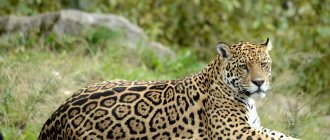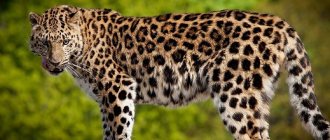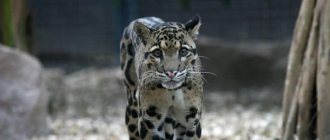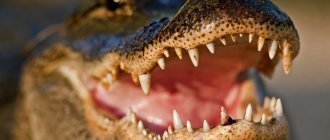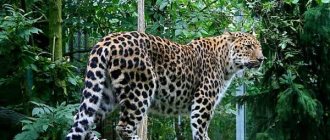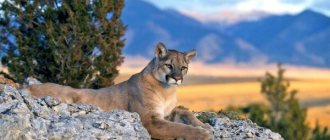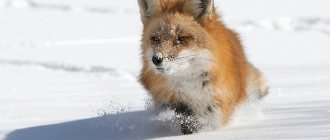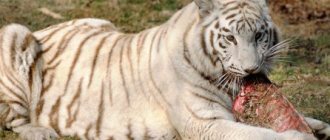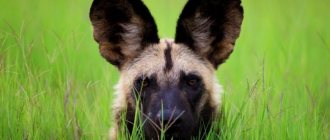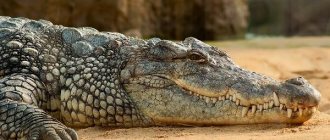Oncilla cat is a unique animal of the cat family, living in the vastness of Central and South America, Argentina, Brazil, Colombia and Costa Rica. There are quite a few cats of this breed in the world today; they are considered very rare and are on the verge of extinction. It has a brindle coloration, which gives it similarities with the jaguar. Its hunting behavior is also reminiscent of the habits of cats leading their lifestyle in the wild.
By family ties, Oncilla is related to the Chilean kitty and the Geoffroy cat. Experts also gave her a middle name - Felis tigrinus (tiger kitten). It is popular, and wealthy people often try to get a “little tiger” at home. What makes this breed so unique?
Captivity
The oncilla is a wild animal, so acquiring one as a pet will bring some difficulties. It is not recommended to keep such a cat in an apartment, and when caring for it you need to remember the following nuances:
In order for an animal to be happy and healthy, it needs to be provided with a spacious enclosure with plenty of open space. It should contain tall trees or artificial objects imitating them, which the animal can use for exercise and relaxation.
It is also important to take care of creating a temperature regime in which the oncilla will feel comfortable. Since these animals are excellent climbers, it is important to take care that they do not escape. All windows in the room where they are kept must be equipped with strong bars
Closed enclosures are preferred. Other small animals, including domestic cats and dogs, should not be allowed into the place where the predator is kept. He can easily perceive them as prey, a threat, or trespassers. Children should also not be allowed near this animal, even if it does not pose a danger to an adult. Oncillas are very independent, obstinate and nocturnal, sometimes making a lot of noise. This should also be taken into account when purchasing such an exotic pet. You need to feed a wild cat with fresh meat - usually beef is used for this. To support health, vitamin and mineral supplements containing various microelements and other necessary substances must be introduced into the diet. When feeding these predators, live food in the form of small rodents or birds is widely used - hunting them allows the animal to maintain itself in good shape. In addition, they need to periodically go on fasting days, following a schedule. The health, diseases and genetic characteristics of this species are very poorly understood. Therefore, it is advisable that a captive predator be under constant veterinary supervision.
The cost of each individual depends on factors such as gender, age, intensity and beauty of color, as well as the quality of the pedigree. The price starts from 2 thousand US dollars, which is about 135 thousand rubles. It is best to buy these exotic animals in nurseries. There, wild cats are raised using special technologies. Kittens undergo strict selection, adapt to humans, and receive the necessary care and vaccinations. A passport and other documents are issued for each animal. Reception staff usually also provide consultations and other services related to the animal’s adaptation to a new habitat.
Security status
Oncilla is known as the small spotted cat, tiger cat, ocelot, or tigrillo, but these names are also used to describe the margay and ocelot cats because their geographic range overlaps significantly.
Oncilli can be mistaken for long-tailed cats (margays) or juvenile ocelots, meaning their presence is difficult to detect in any area. Researchers in Brazil found that few former hunters and the most experienced indigenous people could tell the three species apart.
In southern Brazil, their range overlaps with Geoffroy's cats, and there is some evidence of hybridization between the two species.
Oncillas have been hunted for their fur throughout their range. A report on South American cats found that between 1976 and 1982, oncillas were one of the four most traded small cat species. It is difficult to assess threats to this species when so little is known about it. Scientists suggest the possibility of oncilla existence in deforested coffee and eucalyptus plantations on the outskirts of São Paulo.
Oncillas are classified as "vulnerable" on the IUCN Red List of Threatened Species. Although these cats are protected under Appendix I of CITES (Convention on International Trade in Endangered Species of Wild Fauna and Flora), they are rarely found in protected habitats. The phylogenetics of this species are not well established, and it has been suggested that populations that occur in the northernmost part of their range may represent a distinct species.
At the end of the 20th century, oncillas were a very popular hunting object among poachers. This species gained such popularity due to the beauty of its fur. At the moment, the population of these cats numbers up to 50 thousand individuals. The main threat to the species remains poachers, as well as coffee production, for the cultivation of which forests are cut down in the oncilla's habitats. Hunting these cats is prohibited by law in most countries that cover their habitat.
If you find an error, please highlight a piece of text and press Ctrl Enter.
Distribution and habitat[edit]
Oncillas are distributed from scattered populations in Costa Rica and Panama, and throughout the Amazon basin to central Brazil. It has been recorded in the cloud forests of Costa Rica, in the northern Andes at altitudes of 1,500 to 3,000 m (4,900 to 9,800 ft), and in the arid landscapes of the Cerrado and Caatinga in northern Brazil. [1] In Panama, it was recorded in Darien, [7] and in the Volcán Baru national parks. [8] In Colombia, it has been recorded in the Cordillera Occidental at altitudes of 1,900 to 4,800 m (6,200 to 15,700 ft) in Los Nevados, [9] as well as in the Department of Antioquia. [10]
Hunting and diet
Like all cats, oncilla is a predator. Despite their small size, these animals are very dexterous and skilled hunters, who often kill prey larger than themselves. They prefer to hunt at night. Having spotted a victim, a wild cat can wait in ambush for hours, looking for the right moment to attack. When an unsuspecting animal comes close enough, the oncilla quickly rushes at it, catching up in a few seconds.
Unlike domestic cats, these predators do not have the habit of playing with their prey and kill it with one precise blow to the neck or head. In this they are helped by sharp, strong claws and unusually strong fangs. The diet of oncillas includes:
- small rodents that share their habitat with these wild cats;
- birds from which the predator carefully plucks the feathers before eating;
- eggs left in nests;
- small non-venomous snakes and tree frogs (according to unconfirmed reports);
- fish - if the animal lives near a body of water.
According to some eyewitnesses, in Brazil, oncillas sometimes prey on small monkeys. Their excellent tree-climbing skills allow exotic cats to catch up and kill agile primates, providing themselves with a hearty meal. In hunting, predators are helped not only by their speed and grace, but also by very acute hearing, as well as an excellent sense of smell, which allows them to track prey in the twilight of night forests.
Features of character and lifestyle
Oncillas are solitary cats, like tigers, leopards or jaguars. They prefer to lead a secretive lifestyle, hiding in dense thickets during daylight hours or resting on tree branches. At night, cats go hunting.
Oncillas are territorial cats. Both females and males have a limited range in which they can hunt. Only during the breeding season can males violate these boundaries, and the rest of the time the oncillas intensively mark their territory.
Interestingly, these cats show aggression towards each other. Males are especially aggressive towards females: they can seriously bite them and fatally injure them. Therefore, oncillas try not to enter other people's territory.
Although oncillas are nocturnal, they are very aggressive. Thanks to aggression, they can attack both animals that exceed them in size and rush recklessly towards dangerous predators. Males are more aggressive than females and therefore often suffer from their behavior.
Sometimes oncillas can be active during the day. Most often these are nursing females who are always in search of prey. Also during the rainy season, these cats are most active, although the exact reason is difficult to identify. This is perhaps the most successful period for hunting, as rain masks scent and noise, allowing this predator to be even more deadly.
Oncilla protection
Photo: Oncilla from the Red Book
Oncilla is listed in the Red Book under the status of a vulnerable species. The population has almost been restored, and oncillas are widespread, although very rare. Poaching was a real scourge for the population of these cats, since several tens of thousands of oncillas were destroyed between 1970 and 1980. And in 1983, about 84 thousand skins were confiscated from poachers.
At the moment, there are about 50 thousand adult oncils. The figure is unstable and sometimes increases and sometimes decreases due to deforestation. Hunting for oncillus is prohibited, but in many regions where it lives, it is not awarded the status of a protected animal.
Namely, it is not guarded in the following places:
- Ecuador;
- Guyana;
- Panama;
- Nicaragua;
- Peru.
The International Convention on Trade in Wild Animals and Plants listed oncilla as an appendix back in 1989. No specific work is being done to support or restore the population due to the difficult living conditions of this cat. It is reliably known that the hunt for her has completely stopped.
The oncilla is a beautiful and deadly animal. Despite its cute appearance, this cat is not adapted to life at home due to its natural aggressiveness and increased activity at night. It remains to be hoped that the oncilla population in the wild will be fully restored.
Tags:
- Deuterostomes
- Bilaterally symmetrical
- Wild cats
- Animals of Argentina
- Animals of Brazil
- Animals of Venezuela
- Animals of Guyana
- Animals of Colombia
- Animals of Costa Rica
- Animals of the Red Book
- Animals of the forest
- Animals starting with the letter O
- Animals of Nicaragua
- Animals of Panama
- Animals of Paraguay
- Savannah animals
- Animals of the Subtropical Zone of the Southern Hemisphere
- Animals of the Subequatorial Belt of the Southern Hemisphere
- Rainforest Animals
- Animals of the Tropical Zone of the Southern Hemisphere
- Animals of Uruguay
- Animals of Ecuador
- Animals of South America
- Animals
- Felines
- Cats
- Felidae
- Laurasiotherium
- Small cats
- Placental
- Vertebrates
- Rare animals
- Rare animals of the world
- The most beautiful animals
- Unique animals
- Predatory
- Predatory animals
- Predatory cats
- Chordates
- Ghostostomes
- Quadrupeds
- Eukaryotes
- Eumetazoans
- South American cats
Features of care
This wild species does not require any special care, but do not forget that regular visits to the veterinarian are an essential factor in the growth of a healthy and well-groomed kitten. Of course, wild cats at home need proper and regular nutrition, education and free space.
Did you know? The life of a tiger cat at home is much longer and more comfortable than in the wild. Under natural conditions, oncillas do not live up to 15 years, but in captivity, some individuals lived up to 20 years.
Appearance description
The name "oncilla" translates as "little jaguar". Externally, this cat really looks like a miniature jaguar, not only in color, but also in physique, as well as the general structure of the body.
The animal's fur is soft, but rather short, and the main color is grayish-red. The belly and chest are lighter than the back and sides. Black longitudinal spots stretch along the spine, the tip of the tail is covered with transverse stripes. Dark rings of different shapes and sizes are randomly located throughout the body, not breaking up into specks. Among these predators, individuals with melanism and black coloration are often found - their number reaches 20% of the population.
The size of the wild oncilla is quite small - it is slightly larger than a domestic cat, but is inferior in size to the ocelot and its other relatives that do not live in tropical zones. The weight of a large male is about 2.8−3 kg with a body length of 65 cm. Females are smaller - their body weight rarely exceeds 1.5−2.5 kg. The predator's physique is quite powerful, but this does not prevent him from being dexterous and graceful. The tail is of medium length (up to 35-40 cm) and thickness, mobile. The front legs are slightly shorter than the hind legs. The claws are retractable, strong and sharp.
The ears are rounded, erect and very large, there are no tufts on them. Their light inner part is covered with light fluff, and the outer part is covered with black fur. There is a small white spot approximately in the middle of each ear. There are also characteristic light markings on the animal’s face in the area of the eyelids, cheeks and chin. The eyes of oncillas are large and expressive, very prominent against the background of the entire appearance of the cat. Their color varies from amber yellow and light brown to chocolate. The pupils are narrow and vertical.
Best articles: Rare animals from the Red Book of the Trans-Baikal Territory - list, characteristics and photos
General information
Origin
In 2022, based on research results, three groups of oncilla cats were approved, one of which was recognized as an independent species - the tiger cat. Although, it is difficult for the average person to accept this division, because the classification is based on the texture and variety of patterns on the skins.
Appearance
Although the oncilla is called a tiger cat, it looks like a very small jaguar or its cub. In relation to the size of an ordinary domestic cat, this species of wild cat is slightly larger, but most often about the same.
Females are almost half the size of males, so if we talk about size, you should always consider the lower threshold to be the size of a female, and the upper threshold to be the size of a male. So the body of an adult oncilla is 38-65 centimeters, plus a tail that is 2/3 the length of the body. The weight of a male usually does not exceed 3 kilograms, and that of a female 2.
In terms of the structure of the skeleton and muscles, the cat is built, like all wild species, very harmoniously, has a small flattened head and an elongated muzzle. The ears are without tassels, with sparse white hairs inside and thick black fur on the back wall. The eyes are slightly bulging, the iris is yellow-brown. The nose is charmingly pink, with a black edging. It is distinguished by the extremely close location of the mustache to the nose.
The paws are thin, long, and the pads can hide and extend their claws to their entire length.
IMPORTANT: the population of mini-jaguars is protected by the Red Book as a vulnerable species. This is due to the reduction of natural habitat by humans
The entire color palette of this wild cat is aimed at camouflage in dark foliage and the play of sunlight among the leaves.
INTERESTING: Among wild oncilla cats, approximately 15% of the population are always black. This phenomenon is caused by melanism and is common in many wild tabbys.
Habits and life in the wild
Small, but remote, and also extremely cunning and a real special forces specialist in matters of camouflage - all this is about the tiny oncilla, which, thanks to all these qualities, was able to hide from humans for so long. But the adult oncilla is in no hurry to make contact with its relatives. Active contacts occur only during the rutting period.
The tiger cat does all its business at night; wakefulness during the day is extremely rare and is always caused by a serious irritant in the territory. Oncilla spends 90% of its time on tree branches, where its camouflage ability makes it invisible to most predators and humans in particular.
The habitat of an adult female is approximately 2.5 kilometers, but the male appropriates up to 17 square kilometers. The ranges of males and females may touch, but not overlap. The male and female spend a lot of time just before mating. The period of courtship and being together with cats of this species is very gentle and touching. Typically this period lasts 3-9 days, after which the partners disperse back to their territories.
When hunting, the oncilla doesn’t care where its prey is. This striped cat climbs trees and branches better than any monkey, it also swims and runs excellently, and its assertive and ferocious disposition will not give its prey any chance of escaping. But this does not mean that the oncilla rushes through the jungle for everything that is tasty. She can sit in ambush for enough time to attack at a moment when the victim does not see her at all and does not hear her jump.
Wild oncilla never stores prey on branches, as leopards do, for example. She catches what she can eat at a time and hunts every night for this reason. The most delicious for a tiger cat: mice and rats, gophers, birds, frogs, fish, lizards, macaques and snakes. An interesting fact is that the oncilla not only eats the bird’s carcass, it cleans it of feathers, and can also then feast on the contents of the nest.
When there is a “failure” of small animals in the jungle, the oncilla does not mind snacking on large beetles and larvae.
Links[edit]
- ^ B s d e e Payan, E. & de Oliveira, T. (2016). "Leopard tigrinus". IUCN Red List of Threatened Species
.
2016
: e.T54012637A50653881. - ^ ab Wozencraft, W. C. (2005). "Species Leopardus tigrinus". In Wilson, Delaware; Reader, D. M. (ed.). Mammal Species of the World: A Taxonomic and Geographical Guide (3rd ed.). Johns Hopkins University Press. item 539. ISBN. 978-0-8018-8221-0. OCLC 62265494.
- ^ab Trigo, T.C.; Schneider, A.; de Oliveira, T. G.; Lehugeur, L.M.; Silveira, L.; Freitas, T. R. O., & Eizirik, E. (2013). "Molecular evidence reveals complex hybridization and cryptic species of Neotropical wildcat". Current Biology
.
23
(24):2528–2533. DOI: 10.1016/j.cub.2013.10.046. PMID 24291091. - ^ ab Leyhausen, P. (1963). "Über südamerikanische Pardelkatzen". Zeitschrift für Tierpsychologie
.
20
(5): 627–640. DOI: 10.1111/j.1439-0310.1963.tb01179.x. - ^ abcd Sunquist, M.; Sunquist, F. (2002). Wild cats of the world. Chicago: University of Chicago Press. pp. 130 -134. ISBN 0-226-77999-8.
- University of Michigan Museum of Zoology
- Meyer, N. F., Esser, H. J., Moreno, R., van Langevelde, F., Liefting Y., Oller, D. R., Vogels, C. B. Carver, A. D., Nielsen, C. K. & Jansen, P. A. (2015). "Assessing terrestrial mammal communities in the forests of Central Panama using camera trap surveys". Journal of Nature Conservation
.
26
(26): 28-35. DOI: 10.1016/j.jnc.2015.04.003.CS1 maint: multiple names: authors list (link) - Rodgers, T. W., & Kapheim, K. M. (2017). "Altitude record of the small spotted cat (Leopardus tigrinus oncilla) from Western Panama". Southwestern Naturalist
.
62
(3): 225-227. DOI: 10.1894 / SWNAT D-17-00024.1 .CS1 maint: multiple names: authors list (link) - Payana, E. G. & Gonzalez-Maya, J. F. (2011). "Distribución geográfica de la Oncilla ( Leopardus tigrinus
) en Colombia e implaciones para su conservación."
Revista Latinoamericana de Conservación [Latin American Journal of Conservation]
.
2
(1): 51-59. - Arias-Alzate, A., Sanchez-Londoño, J. D., Botero-Canola, S., & Gonzalez-Maya, J. F. (2014). "Recent confirmed records of oncilla ( Leopardus tigrinus
) in the department of Antioquia, Colombia."
Notas Mastozoológicas
.
1
(2): 4-5.CS1 maint: uses authors parameter (link) - Leyhausen, P. & Tonkin, B. A. (1979). “Cat behavior. Predatory and social behavior of domestic and wild cats." New York: Garland STPM Press. Cite journal requires |journal= (help)
- ^ abc Nowell, K., Jackson, P. (1996). Wildcats: A Status Review and Conservation Action Plan. Hardware: IUCN.CS1 maint: multiple names: authors list (link)
- Quillen, P. (1981). "Hand raising a spotted cat or oncilla." International Yearbook of Zoos
.
21
: 240–242. DOI: 10.1111/j.1748-1090.1981.tb01994.x. - ^ a b de Oliveira, T., Schipper, J., & Gonzalez-Maya, J. F. (2008). "Leopardus tigrinus ssp. Oncilla". IUCN Red List of Threatened Species
.
2008
.CS1 maint: uses authors parameter (link) CS1 maint: ref=harv (link)old-form url - https://felids.wordpress.com/2010/11/03/featured-feline-oncilla/ International Endangered Cat Society
- Lucerini, M.; Eizirik, E.; de Oliveira, T.; Pereira, J.; Williams, R. S. R. (2016). "Bell Leopard". IUCN Red List of Threatened Species
.
2016
: e.T15309A97204446. DOI: 10.2305/IUCN.UK.2016-1.RLTS.T15309A97204446.en. Retrieved January 15, 2018. - do Nascimento, F.O.; Feijo, A. (2017). "Taxonomic revision of the tigrina species group Leopardus tigrinus (Schreber, 1775) (Carnivora, Felidae)". Papéis Avulsos de Zoologia
.
57
(19): 231–264. DOI: 10.11606/0031-1049.2017.57.19. - ^ abc Forman, G. E. (editor) (1988). "Bibliography of Felid 1781-1988". Columbus, OH: Felid Research and Conservation Interest Group: 34–72. Cite journal requires |journal= (help)CS1 maint: extra text: authors list (link)
- ^ abc Fuller, K. S., Swift, B. (1985). Latin American Wildlife Trade Laws
. Washington, DC: Traffic (USA).CS1 maint: multiple names: authors list (link) - Eizirik, E.; Trigo, T.S.; Haag, T. (2007). "Conservation genetics and molecular ecology of Neotropical felids". In Hughes, J.; Mercer, R. (ed.). Felid Biology and Conservation Conference September 17–19
. Oxford, UK: WildCRU. pp. 40–41.
Origin of the species and description
Photo: Oncilla
Oncilla is an unusual member of the cat family. This medium-sized cat is a deft hunter in its habitat. Although wild cats tend to be large, the oncilla is a small animal, but its size gives it an advantage over its competitors in the food chain. There are several subspecies of oncilla, which differ mainly in their habitat.
As a rule, there are three of them, although the latter is often divided into two more subspecies:
- Leopardus tigrinus tigrinus;
- Leopardus tigrinus guttulus;
- Leopardus tigrinus pardinoides.
These species also differ in color and pattern texture, although the differences are minor, so the classification of oncills is often questioned. Wild cats descended from miacidae - creatures that looked similar to large martens, which lived back in the Paleocene. During the Oligocene, these animals became harsh carnivorous predators, occupying the top of the food chain.
Video: Oncilla
It was then that the main subfamilies of cats began to separate:
- big cats such as tiger, lion, cheetah, leopard;
- small cats - manul, forest cat, oncilla and domestic species;
- saber-toothed cats that became extinct at the end of the Pleistocene.
The classification of Oncilla as a small cat is conditional, since it is still larger than other representatives of small cats, but at the same time significantly smaller than the subfamily of big cats. The closest relative of the oncilla at the present time is the leopard (or panther). The similarity is conditional, since the oncilla is only similar to a leopard in color, and therefore in its lifestyle, which is due to constant camouflage.
Buying an Oncilla kitten
Despite the fact that fishing is prohibited by the state. Since this type of cat is at the stage of extinction, it is still possible to purchase an Oncilla kitten in special enclosures where they are raised for sale. Such a nursery must be strictly specialized, since it needs to be grown using special methods.
Frisky kids
Each person has a personal passport indicating their pedigree and all necessary vaccinations. It is not possible to purchase a tiger cat in Russia; such an order must be placed directly from the American continent. Oncilla kitten price starts from five thousand dollars.
Lifestyle and nutrition
The oncilla cat is a secretive animal, and therefore little studied. Prefers to live and hunt alone. It changes its “traditions” only during the period of mating and caring for offspring. Leads a twilight lifestyle and is rarely seen by humans. Swims well and climbs trees. Favorite resting place is tree branches. She sleeps on them during the day and hides from natural enemies, uses the branches as an observation point and as a platform for the decisive jump during the hunt.
A harmless and charming appearance hides a dangerous predator under its veil. The beast is cruel to its victims and, when very hungry, leaves them no chance of salvation. When hunting, oncilla uses techniques proven by its feline relatives - it sneaks up, looks out for prey from cover, and sits in ambush for hours. When the opportunity arises, it unexpectedly pounces on prey, piercing its throat or neck with its long fangs.
Acute vision and good hearing help them find food at night in pitch darkness. The animal is aggressive and can attack prey that is larger than it. From such unequal battles he often emerges victorious.
It usually feeds on small rodents, snakes, tree frogs, birds, steals eggs from bird nests, and sometimes catches fish. Small primates are also included in the diet; they are hunted by individuals living in Brazil. Oncilla is not inferior to monkeys in agility and jumping ability and overtakes them during a hunt without much effort.
How do they behave in the wild?
Due to its small size, Oncilla in the wild runs the risk of injury from larger relatives, including predators. Therefore, she is very careful and leads a life closed from view. But there are times when it boldly enters into a fight with a larger predator and wins it.
Characteristics of Oncillus behavior include the following features:
- Activity occurs in the dark - late evening or early morning.
- During marriage, he gets along with a representative of the same sex, but then prefers to live alone.
- The Oncilla cat lives most of its life in trees, where it sleeps, eats and hunts.
- Both sexes of this breed ardently protect their habitat and can fight with each other. An exception occurs during the mating period of individuals.
- He knows how to swim and feels free in the water.
- Hunting is done from cover. The victims are birds and small rodents. First, the kitty looks for a victim for a long time, and then attacks it.
- The animal is a monogamous animal; in captivity it prefers mating with only one individual of the opposite sex.
Felis tigrinus tiger kitten
Description and photo of oncilla
Natural living conditions for a tiger-colored cat are tropical and subtropical forests and eucalyptus thickets. An adult oncilla is very similar to a baby jaguar due to almost the same color. Among its relatives, the tiger cat is the smallest and most similar in size to ordinary domestic cats. Its weight does not exceed 3 kg, body length - 60–65 cm. The body is muscular, the head is round, small, with an extended muzzle. Relative to the head, the ears are quite large, without tassels at the ends, and erect. The inner surface of the ears is light, has a sparse edge, while the back part is black with a white spot.
Best articles: TOP 7 representatives of the animal world of Siberia - characteristics, photos and videos
The eyes are very large, stand out on the muzzle, have vertical narrow black pupils, and the eye color is yellow-brown. The tail is of medium thickness, up to 40 cm in length. Paws with long and sharp claws, and the hind legs are slightly longer than the front ones. The cat's ocher fur is very soft, although short. The entire body, except the belly and chest, is covered with dark ring-shaped spots of dark color and irregular shape. The chest and belly are covered with white hair. On the tail, the spots turn into transverse lines, which form a solid dark-colored spot at the tip of the tail.
Did you know? 20% of oncilla babies are born completely black. They are called melanists; they differ from their relatives only in the color of their skin and produce healthy offspring.
Place in the ecosystem
The wild Oncilla breed lives in the subtropical forests of Central and South America, Brazil, Argentina, Paraguay, Guyana, Peru, and French Guiana. It is difficult to see these animals in the trees due to their small numbers. However, there are cases when tiger cats were located near human habitation.
Oncillas perform an important function in the ecosystem of the entire planet as predators. They clean the areas in which they live from harmful rodents and small pests.
Reproduction of oncilli
Since, as noted above, this species has been little studied, the reproduction of oncilli can only be judged by their behavior in captivity. The female's estrus does not last long, only a few days. Once pregnant, she bears the offspring for about 10–11 weeks. There are usually 1 to 2 cubs in a litter.
Like most cat species, kittens are born blind. Their eyes open only 20 days after birth. The lactation period lasts up to 3 months, after which the mother cat gradually switches the kittens to a meat diet. Sexual maturity in oncills occurs in the second year of life.
Nothing is known about the reproduction of oncilla in nature.
Purchasing a kitten
The price of an oncilla cat depends on the intensity of the color of the skin, the beauty of the pattern and pedigree. The animal is a rare species, so it should be purchased from a nursery on order. There you can find out exactly how much an oncilla cat costs. Kittens in the nursery undergo strict selection, are raised using special technology, are registered and receive passports with information about their vaccinations.
The nursery staff helps solve all problems related to the animal’s adaptation to new conditions, nutrition, education, and taming. The price of a kitten will start at $2000.
Reproduction and care of offspring
Absolutely all information about oncilla reproduction was obtained by observing individuals kept in captivity. Females of these animals reach sexual maturity at the age of one year, and males at one and a half years. The mating season occurs in February and March. Estrus in cats lasts 3-9 days, its duration decreases with age. At this time, males actively court females and fight for them. The whole process is accompanied by loud growls and screams.
Pregnancy in females lasts from 74 to 78 days. The cubs are born blind, helpless and very small - their weight is no more than 100 grams. Usually there is only one kitten in a litter, rarely there are two or three. The eyes of small onicillae open in the second or third week of life, and teeth begin to erupt at the age of 20-23 days.
For the first three months, kittens are completely dependent on their mother and feed on her milk. When they are 12-13 weeks old, the cat gradually switches them to a meat diet and teaches them to hunt - it is during this period that the babies’ teeth develop sufficiently. At the age of 3.5 months, kittens completely switch to solid food.
At the same time, the oncilla cubs become almost independent of their mother and begin to play, hunt and run around the enclosure on their own. But this only happens in the safe environment of a zoo - it is unknown how long kittens remain with their mother in the much more aggressive wild forests. At 11 months, small predators reach the size of an adult.
Social structure and reproduction
Oncillas spend a lot of time with potential partners during the breeding season. Males and females find each other by smell and begin a kind of acquaintance. They lie together a lot, rub their faces against each other and act very friendly.
Females become sexually mature at the age of two years, and males can produce offspring as early as a year and a half after birth. The period of estrus lasts 3-9 days, during which mating games are held.
Oncillas mate in March, and pregnancy continues for 75 days. After mating, the male leaves the female and returns to the normal rhythm of life. During the season, the female usually brings one kitten, but sometimes there are two or three.
Newborn kittens are helpless and barely reach a weight of 100 grams. They open their eyes in a week at best, but sometimes blindness can last up to 18 days. The female keeps them in a secluded place: in dense bushes, thickets, or someone’s abandoned hole. The cubs live there until they can eat meat - and this is approximately 5-7 weeks after birth.
Teeth grow very quickly, literally within a few hours after 21 days after birth. This is a late date, but is compensated by the fact that the kittens acquire all their teeth at once. Only at 4 months do kittens become completely independent from their mother, and reach adult size only after a year.
Oncilla cat lifestyle
Habits
Oncilla cat lifestyle
Oncilla cats are typical representatives of the cat family, especially regarding their characteristic predatory features. Therefore, do not be surprised at the nocturnal lifestyle of such a cat, which goes hunting at dusk and does not deny itself the pleasure of night walks. True, in the conditions of its habitat (subtropical forests are almost in “twilight” even on the sunniest day), such a cat can be found during the day.
We have already said that oncilla cats are predators. Therefore, their diet is appropriate - small rodents, birds (it is noteworthy that before dining on a bird, the oncilla will clean it of feathers), non-venomous snakes, tree frogs (the tiger cat loves and knows how to swim). But the Brazilian oncillas even feed on small primates (oncillas are great at climbing trees and are not inferior in their dexterity even to monkeys). The hunting scenario, regardless of the size of the animal, is the same for oncilla cats - to lie in wait for prey, attack it, and pierce the skull with your sharp teeth so as to get to the brain...
Due to their character, oncilla cats are truly fearless creatures; they can even fight with an animal larger than the cat itself. And, surprisingly, often, thanks to their fearlessness and drive, oncillas emerge victorious even from such an unequal battle.
It is quite clear that the description of this lifestyle does not apply to domestic oncillas, and those at home are cute and affectionate creatures. But, always remember that the blood of a subtropical predator still flows in the veins of your domestic cat Oncilla.
Reproduction
The period of “festivities” for these cats occurs at the beginning of spring (like real representatives of the cat family), and their pregnancy lasts up to 78 days. A cat can give birth to up to 3 kittens at a time, although, as a rule, only 1 kitten is born. The eyes of small oncills open only on the 21st day (this is quite unusual for such predators), and teeth also appear by the end of 3 weeks - and, all at once, within a few hours, which cannot be said about other representatives of the cat family. Sexual maturity in females occurs at 2-2.5 years, and in males much earlier, at 18 months from birth.
Already from the 3rd month of their life, oncilla cats can eat solid food and become more independent and less dependent on their mother cat.
Oncilla cat population
And, although today zoology can tell a lot about almost any representative of the animal world, including cats, not much is actually known about oncilla cats. And, most of the information available today is the results of objective observations of oncillus cats living in zoos around the world. It is likely that in the wild these cats behave slightly differently.
Despite their charming appearance, these cats are in danger, and, instead of love and adoration from humans, they do not see anything good from it, since they are valuable to the latter as a source of beautiful and thick fur. Therefore, today Oncilla cats are on the verge of extinction, and the population of these cats is only 50 thousand. This figure is negligible, especially against the backdrop of data that suggests that
Zoologists say that the oncilla cat can be easily tamed, but, nevertheless, at home this exotic animal is a real rarity. But, if you are lucky enough to tame this tiger cat, we will be glad if you share with us information about what habits this animal has in a home environment...
We are waiting for your feedback and comments, join our VKontakte group!
Excerpt characterizing Oncilla
- Nothing. There’s no need to cry here,” he said, looking at her with the same cold gaze. When Princess Marya began to cry, he realized that she was crying that Nikolushka would be left without a father. With great effort he tried to return to life and was transported to their point of view. “Yes, they must find it pathetic! - he thought. “How simple it is!” “The birds of the air neither sow nor reap, but your father feeds them,” he said to himself and wanted to say the same to the princess. “But no, they will understand it in their own way, they will not understand! What they cannot understand is that all these feelings that they value are all ours, all these thoughts that seem so important to us are that they are not needed. We can't understand each other." - And he fell silent. Prince Andrei's little son was seven years old. He could barely read, he didn't know anything. He experienced a lot after this day, acquiring knowledge, observation, and experience; but if he had then possessed all these later acquired abilities, he could not have understood better, more deeply the full meaning of that scene that he saw between his father, Princess Marya and Natasha than he understood it now. He understood everything and, without crying, left the room, silently approached Natasha, who followed him out, and shyly looked at her with thoughtful, beautiful eyes; his raised, rosy upper lip trembled, he leaned his head against it and began to cry. From that day on, he avoided Desalles, avoided the countess who was caressing him, and either sat alone or timidly approached Princess Marya and Natasha, whom he seemed to love even more than his aunt, and quietly and shyly caressed them. Princess Marya, leaving Prince Andrei, fully understood everything that Natasha’s face told her. She no longer spoke to Natasha about the hope of saving his life. She alternated with her at his sofa and did not cry anymore, but prayed incessantly, turning her soul to that eternal, incomprehensible, whose presence was now so palpable over the dying man. Prince Andrei not only knew that he would die, but he felt that he was dying, that he was already half dead. He experienced a consciousness of alienation from everything earthly and a joyful and strange lightness of being. He, without haste and without worry, awaited what lay ahead of him. That formidable, eternal, unknown and distant, the presence of which he never ceased to feel throughout his entire life, was now close to him and - due to the strange lightness of being that he experienced - almost understandable and felt. Before, he was afraid of the end. He experienced this terrible, painful feeling of fear of death, of the end, twice, and now he no longer understood it. The first time he experienced this feeling was when a grenade was spinning like a top in front of him and he looked at the stubble, at the bushes, at the sky and knew that death was in front of him. When he woke up after the wound and in his soul, instantly, as if freed from the oppression of life that held him back, this flower of love, eternal, free, independent of this life, blossomed, he was no longer afraid of death and did not think about it. The more he, in those hours of suffering solitude and semi-delirium that he spent after his wound, thought about the new beginning of eternal love that had been revealed to him, the more he, without feeling it himself, renounced earthly life. Everything, to love everyone, to always sacrifice oneself for love, meant not loving anyone, meant not living this earthly life. And the more he was imbued with this principle of love, the more he renounced life and the more completely he destroyed that terrible barrier that, without love, stands between life and death. When, at first, he remembered that he had to die, he said to himself: well, so much the better. But after that night in Mytishchi, when the one he desired appeared in front of him in a semi-delirium, and when he, pressing her hand to his lips, cried quiet, joyful tears, love for one woman imperceptibly crept into his heart and again tied him to life. Both joyful and anxious thoughts began to come to him. Remembering that moment at the dressing station when he saw Kuragin, he now could not return to that feeling: he was tormented by the question of whether he was alive? And he didn't dare ask this. His illness took its own physical course, but what Natasha called: this happened to him happened to him two days before Princess Marya’s arrival. This was the last moral struggle between life and death, in which death won. It was the unexpected consciousness that he still valued the life that seemed to him in love for Natasha, and the last, subdued fit of horror in front of the unknown.
Description
Oncilla is one of the smallest wild cats in South America.
Body weight is 1.5 kg-3 kg. Males are slightly larger than females and can weigh up to 3 kg, while females weigh 1.5-2.0 kg. The body length of the male, including the head, is 805-830 mm, the tail length varies in the range of 317-360 mm. The body length of the female ranges from 763-780 mm, and the tail - 270-305 mm. Oncillas have short, thick fur that ranges in color from light brown to gray. The body is covered with black rosettes with a dark brown center. The belly is usually lighter than the rest of the body, but is also marked with rosettes. The tail has 7 to 13 dark rings and ends in a dark tip. The limbs are randomly covered with black spots. The back of the ears is black, with a white spot in the center. The eyes are golden or light brown. Although melanism has been documented in this species, albinism has not been reported.
Best articles: The process of cellular respiration and its stages
Oncilli are often mistaken for ocelots and long-tailed cats (margays). What is the difference between these 3 species, read the article “Tiger cats: ocelot, margay, oncilla, and their comparative characteristics.”
The following are the traditionally recognized subspecies:
- Leopardus tigrinus tigrinus, eastern Venezuela, Guyana, northeastern Brazil;
- Leopardus tigrinus guttulus, Brazilian Atlantic forest in central and southern Brazil, Uruguay, Paraguay, northern Argentina;
- Leopardus tigrinus oncilla
, Central America; - Leopardus tigrinus pardinoides, western Venezuela, Colombia, Ecuador, Peru.
Classification of wild cats
In 1999, researcher Johnson described the strict differences between Leopardus tigrinus oncilla and Leopardus tigrinus guttulus . This gave scientists a reason to divide Oncilla into two main species. These two separate populations were completely isolated along the Amazon River for 3.7 million years. The described species lived separately and did not interbreed.
However, in 2013, Leopardus guttulus (as researchers began to call it for short) was identified as a separate species - the southern tiger. Its habitat is the subtropical forests of Brazil, Paraguay, Uruguay and Argentina. Through a morphological assessment of the subspecies, scientists came to the conclusion that there are three groups of Oncilli cats according to their region of residence on the South American continent: northwestern, eastern and southern.
Life in captivity
Oncilla is known to be a rather aggressive cat, so it is not recommended to keep it in an apartment or house. It is only suitable for aviary keeping. If a person has fed a kitten from the age of 2-3 weeks, the oncilla may get used to it and not show aggression.
When keeping an oncilla in an enclosure, it is necessary to create conditions close to natural ones. The enclosure must be at least 100 m2 in area and at least 3–4 m in height. The cat should have enough space to run, jump and climb. You also need to equip secluded places where she can hide, and a small pond for swimming. A heat-loving cat will also need a winter enclosure with the same conditions.
Oncillas are difficult to tame, so they should not be kept indoors.
You can buy an oncilla kitten abroad, in special wild cat nurseries. Price starts from $2000. When purchasing, you must request from the breeder all the documents required by the CITES Convention.
Animal care
In captivity, the oncilla does not require special care - it does not need to be bathed, as it takes care of its coat on its own. If the cat trusts the person, it can be brushed about 2 times a month. You can feed the oncilla only with lean raw meat - poultry, rabbit, etc. It is also necessary to keep the cat's enclosure perfectly clean. The strong health of the oncilla can be affected by an unusual climate, so it needs to be examined regularly. She needs to have all the vaccinations required for domestic cats.
Caring for an oncilla does not require as much effort as caring for domestic cats.
Despite its small size, oncilla is a dangerous and aggressive predator. She prefers to hide, but if she is in danger, she defends herself fiercely and fearlessly. Unfortunately, due to lack of proper protection, there are few of these beautiful cats left in the wild. Therefore, probably very soon we will only be able to see them in zoos and private menageries.
Caring for Oncilla
In the created enclosure, the animal will not require special care. The wild cat carries out water procedures itself. If you trust, you can comb your pet's fur a couple of times a month, but this is also not particularly necessary. Oncilla feeds mainly on raw, lean fillets: rabbit and various birds. The enclosure must be kept impeccably clean so that the cat feels comfortable.
Maintenance necessarily involves regular examination by veterinarians and necessary vaccinations. Oncilla is a predator by nature, which can show aggression towards others and actively defend itself. Unfortunately, the population is decreasing and very soon they may remain only in private enclosures.
Oncilla
Oncilla (Leopardus tigrinus)
- a species of wild cat from Central and South America.
It is the ocelot (Leopardus pardalis)
and
margay (Leopardus wiedii)
cats .
Oncilla is one of the smallest wild cats in South America
. Body weight is 1.5 kg-3 kg. Males are slightly larger than females and can weigh up to 3 kg, while females weigh 1.5-2.0 kg. The body length of the male, including the head, is 805-830 mm, the tail length varies in the range of 317-360 mm. The body length of the female ranges from 763-780 mm, and the tail - 270-305 mm.
Oncillas have short, thick fur that ranges in color from light brown to gray. The body is covered with black rosettes with a dark brown center. The belly is usually lighter than the rest of the body, but is also marked with rosettes. The tail has 7 to 13 dark rings and ends in a dark tip. The limbs are randomly covered with black spots. The back of the ears is black, with a white spot in the center. The eyes are golden or light brown. Although melanism has been documented—approximately 20% of the population is black—albinism has not been found in this species.
Oncillus are often mistaken for ocelots
and long-tailed cats (margay)
.
What is the difference between these 3 species, read below
in the article
“Tiger cats: ocelot, margay, oncilla, and their comparative characteristics.”
Traditionally recognized subspecies of oncilla:
Leopardus tigrinus
They mainly live in South America, and small populations of these cats can also be found in Central America. They can be found both in Costa Rica and Argentina. Its geographic range extends throughout Brazil and the Guianas (i.e., Guyana, Guiana, Suriname) and parts of Venezuela, Colombia, Ecuador, Bolivia, and Paraguay. There is also speculation that they may be found in certain areas of Nicaragua and Panama.
Habitat
Oncilla
, also known as small spotted cats
and
small tiger cats
, have been recorded at altitudes up to 3200 m above sea level.
They prefer forest habitats and are found in a wide variety of forest ecosystems, including dense tropical forests up to 1500 m above sea level. From 350 to 1500 m, oncilli can be found in tropical or moist forests. From 1500 m and above, this species can be found in moist montane forests or tropical rainforests. Available evidence suggests that their populations increase in deciduous and subtropical forests, and in Brazil, they successfully colonize savannas and semi-arid thorny scrub. Although oncillas are deft tree climbers, they are primarily terrestrial animals.
Reproduction
There is no information regarding the breeding system of oncillas in the wild, however, in captivity, individuals mate with the same partner.
Although oncillas are primarily solitary animals, they spend time with their mate during breeding. In captivity, these cats mate with one partner, however, this has not been confirmed for wild individuals. In the wild, males are known to be very aggressive towards females and it can be assumed that the species is solitary.
Females reach sexual maturity after 2 years, while males become sexually mature at 18 months. Estrus lasts from 3 to 9 days and its duration decreases with age. Mating occurs in early spring and pregnancy lasts for approximately 75 days. Males take no further part after mating. During the breeding season, 1 kitten is born, but sometimes 2-3.
Newborns weigh between 92 and 134 g and open their eyes 7 to 18 days after birth. Kittens begin to eat solid food at 5-7 weeks after birth, and are weaned from their mother's milk at 3 months of age. Teeth begin to appear after 21 days, which is later than most felines; however, the teeth usually appear all together within a few hours. Most oncilli are fully grown by 11 months and become fully independent by 4 months of age.
Lifespan
Oncillas typically live 10-14 years in the wild. They are known to live up to 23 years in captivity, but most individuals live 16-20 years.
Characteristics of Oncilla
Externally, the Oncilla cat resembles a small jaguar. It is difficult to recognize a mature kitten among the cubs of the jaguar itself. Among wild cats, it is one of the smallest, in appearance it is slightly larger than an ordinary domesticated breed.
Brindle color
External features
The characteristics of the external physique are as follows:
- The coat color is usually sandy; completely black Oncillas are extremely rare.
- The coat pattern is brindle and consists of random spots.
- Weight reaches parameters up to 2 kg in cats and up to 3 kg in males.
- Body length: 75 cm – females, 80 cm – males.
- The length of the tail is 27 cm in females, 31 cm in males.
- The head is small, elongated.
- The ears are large, with a black outer surface.
- The eyes are large, the color of the eyes is greenish or yellow.
- Posture is straight, the back has visually elastic features.
- The coat is short, thick, smooth to the touch.
Where do Oncillas live?
The main place of residence is the northeast of the South American continent. Among the features of their habitat are the following:
- Oncillas prefer to live in subtropical forests with high humidity above 1500 m above sea level.
- In forests with deciduous trees, their population is found no higher than 1500 m above sea altitude.
- In Brazil, these wild creatures can choose to live in dry savannah areas.
- The distribution altitude of the population reaches the range of 350-3200 m above sea level.
The population of Oncilli cats in nature numbers approximately 50 thousand adult individuals, which is a critically small number, therefore they are under state protection. Changes in the population towards decrease occur due to deforestation of forest areas and hunting by poachers.
